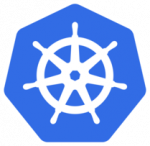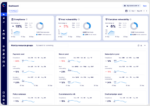
Nowadays customers have high expectations of (online) services and what a business can (or should) deliver. To meet up to those high expectations, businesses need to transform the way they work and think and even their organizational culture. This involves major changes in day-to-day operations. As a result of these changes, customer value will increase.
Enterprises try to achieve this change by adopting new technologies to help them modernize their operations. This is called digital transformation. Digital transformation solves traditional problems by integrating technology into all levels and departments of companies. It is also one of the most hyped buzzwords of the last years. Open any IT blog and you’ll see the word immediately. There’s no escaping. So, how come many companies still struggle to achieve digital transformation?
The key to digital transformation is gaining the ability to efficiently develop and launch new applications or features. Efficiency used to be about working faster and cheaper to increase profit. Nowadays, working efficiently means that you focus on company growth by increasing customer value and improving the customer experience. Because in the end, customers want new features or applications that scale and they want them yesterday.
Now imagine maintaining existing applications who are built with old-fashioned tools and keeping your infrastructure up-to-date and at the same time growing new capabilities to match the customer’s desires. Seems impossible since every company has only so many resources to spend. That’s why we need to focus on automation. By automating daily operations and applications, we save resources. This gives you more time and money to spend on reaching your business goals.
Automation is a difficult thing to achieve within enterprises because it requires company-wide integration and collaboration. Plus, there is a skill gap between several functions that makes working together difficult and most automation tools solve only one problem while it takes a lot of time and effort to adopt them.
Evolving your operations into an automation driven development life-cycle can be achieved by:
- Containerizing your applications
- Adopting the DevOps way of working
- Choosing the right platform that facilitates collaborative change and automation of your operations
Containerizing your applications
With companies focusing on digital transformation, software is becoming a core part of those companies. The goal of integrating software into the foundation of a company is mostly agility and automation. Containerization plays a big part in enabling automation. By putting your applications in containers, they aren’t stuck to the operations system anymore. This allows developers to focus on functionality where they used to worry about the infrastructure as well. You can place your applications in containers using Docker, but this alone doesn’t do the trick. You’re still missing scaling, scheduling, recovery and many more useful features. This is where Kubernetes comes in.
Kubernetes is the industry standard platform for container application development and delivery. It solves the problem of the complexity of automation. With Kubernetes you have one endpoint and tool to manage and maintain your applications and one dashboard to work from.
Containers make applications portable. Packaging applications and their configuration are easier with Kubernetes and you can deploy your application within seconds in any environment. However, working with containers asks for a modernized and cloud-based infrastructure. Work progress needs to become more agile across IT and the rest of the organization. This is where the DevOps way of working comes around.
DevOps way of working
Although everybody knows the word DevOps, most people associate it with a role. But it isn’t. DevOps is about organizational culture and structure that allows developers and the operations team to work together in an agile way. In the end, the organizational structure should support a continuous delivery pipeline. With this pipeline, bottlenecks in the software development and deployment process can be overcome. This results in better features or products for customers that can be pushed to production faster.
DevOps is about the entire process of work. Where developers used to work on building big, new features and pushing them to production at big releases, it’s now about smaller changes, testing and learning. By making smaller changes to the code and testing them before pushing them to production, safety and progress are ensured.
Shifting towards the DevOps way of working involves not only the IT team but the entire company. Although the biggest change might be for the operational team (they need to adopt an agile way of developing), management has to worry about data security, testing and creating a high-trust cultural norm. Colleagues should be able to discuss their failures and what they learned from them and responsibilities need to be shared. It’s not about what someone did today, but about what they have learned and how this will help the company grow. In the end, DevOps is about collaboration. The tools you use don’t really matter. But the right toolchain could massively enhance collaborative change.
A platform that facilitates collaboration and automation
We introduced Kubernetes as the industry standard platform to develop and deliver applications in containers. However, the biggest challenge of Kubernetes is bringing it to production within your company. And although Kubernetes enables monitoring, scaling and easy application management, it doesn’t cover the entire load that is needed for digital transformation. Because, as mentioned before, for digital transformation you need a tool that encourages collaborations and the DevOps workflow as well.
By now, more and more tools emerge that enable both automation and collaboration. However, one of the leading platforms on the market is OpenShift by Red Hat. OpenShift is a Platform-as-a-Service solution that supports the entire application life-cycle. From developing to testing, deploying and management. It is built on containers that are orchestrated by Kubernetes, but it offers a lot more.
OpenShift is known as a solid and flexible platform that supports important innovations to enable digital transformation (like migrating to the hybrid cloud, containerization and adopting microservices). Continuous application management needs less time and developers only have to focus on delivering applications and features. But wait, this sounds a lot like Kubernetes, so what are the differences?
- Kubernetes is available on more cloud providers than OpenShift, but in a vendor-specific way. OpenShift is vendor neutral. However, the out of the box toolstack is chosen by Red Hat;
- OpenShift is a supported product whereas Kubernetes is an Open Source project. As a OpenShift customer, you have to renew subscriptions and pay when your cluster grows. With Kubernetes this depends on the service provider (if you have one);
- OpenShifts’ approach to security is more advanced than Kubernetes’. You can’t run containers as root in OpenShift and OpenShift features Role Based Access Control;
- The web interface of OpenShift is more user-friendly. You can manage many day-to-day tasks from within the OpenShift dashboard. Kubernetes and OpenShift both feature a command-line interface, which is targeted at more experienced users;
- OpenShift has more deployment options using DeploymentConfig in addition to Kubernetes’ classic Deployment. OpenShift also offers ImageStreams: ImageStreams makes it easier to change a tag of an image without having to download, change and push it all over again. If you make a change in the image using ImageStreams, the change automatically pushes a new version Build;
- OpenShift is integrated with Jenkins CI/CD pipelines. Use it to build container images, perform continuous integration tasks and deploy them on containers in multiple environments. OpenShift also supports source-to-image to create a custom image that automatically updates when changes are made.
To learn more about containerized infrastructure and cloud native technologies, consider coming to KubeCon + CloudNativeCon San Diego, Nov. 18-21.
For more information about OpenShift visit www.proteon.com.







